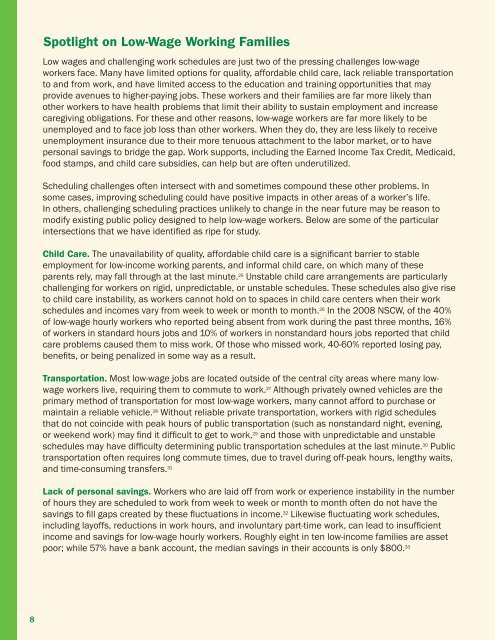Flexible Workplace Solutions for Low-Wage Hourly Workers
Flexible Workplace Solutions for Low-Wage Hourly Workers
Flexible Workplace Solutions for Low-Wage Hourly Workers
Create successful ePaper yourself
Turn your PDF publications into a flip-book with our unique Google optimized e-Paper software.
Spotlight on <strong>Low</strong>-<strong>Wage</strong> Working Families<br />
<strong>Low</strong> wages and challenging work schedules are just two of the pressing challenges low-wage<br />
workers face. Many have limited options <strong>for</strong> quality, af<strong>for</strong>dable child care, lack reliable transportation<br />
to and from work, and have limited access to the education and training opportunities that may<br />
provide avenues to higher-paying jobs. These workers and their families are far more likely than<br />
other workers to have health problems that limit their ability to sustain employment and increase<br />
caregiving obligations. For these and other reasons, low-wage workers are far more likely to be<br />
unemployed and to face job loss than other workers. When they do, they are less likely to receive<br />
unemployment insurance due to their more tenuous attachment to the labor market, or to have<br />
personal savings to bridge the gap. Work supports, including the Earned Income Tax Credit, Medicaid,<br />
food stamps, and child care subsidies, can help but are often underutilized.<br />
Scheduling challenges often intersect with and sometimes compound these other problems. In<br />
some cases, improving scheduling could have positive impacts in other areas of a worker’s life.<br />
In others, challenging scheduling practices unlikely to change in the near future may be reason to<br />
modify existing public policy designed to help low-wage workers. Below are some of the particular<br />
intersections that we have identifi ed as ripe <strong>for</strong> study.<br />
Child Care. The unavailability of quality, af<strong>for</strong>dable child care is a signifi cant barrier to stable<br />
employment <strong>for</strong> low-income working parents, and in<strong>for</strong>mal child care, on which many of these<br />
parents rely, may fall through at the last minute. 25 Unstable child care arrangements are particularly<br />
challenging <strong>for</strong> workers on rigid, unpredictable, or unstable schedules. These schedules also give rise<br />
to child care instability, as workers cannot hold on to spaces in child care centers when their work<br />
schedules and incomes vary from week to week or month to month. 26 In the 2008 NSCW, of the 40%<br />
of low-wage hourly workers who reported being absent from work during the past three months, 16%<br />
of workers in standard hours jobs and 10% of workers in nonstandard hours jobs reported that child<br />
care problems caused them to miss work. Of those who missed work, 40-60% reported losing pay,<br />
benefi ts, or being penalized in some way as a result.<br />
Transportation. Most low-wage jobs are located outside of the central city areas where many lowwage<br />
workers live, requiring them to commute to work. 27 Although privately owned vehicles are the<br />
primary method of transportation <strong>for</strong> most low-wage workers, many cannot af<strong>for</strong>d to purchase or<br />
maintain a reliable vehicle. 28 Without reliable private transportation, workers with rigid schedules<br />
that do not coincide with peak hours of public transportation (such as nonstandard night, evening,<br />
or weekend work) may fi nd it diffi cult to get to work, 29 and those with unpredictable and unstable<br />
schedules may have diffi culty determining public transportation schedules at the last minute. 30 Public<br />
transportation often requires long commute times, due to travel during off-peak hours, lengthy waits,<br />
and time-consuming transfers. 31<br />
Lack of personal savings. <strong>Workers</strong> who are laid off from work or experience instability in the number<br />
of hours they are scheduled to work from week to week or month to month often do not have the<br />
savings to fi ll gaps created by these fl uctuations in income. 32 Likewise fl uctuating work schedules,<br />
including layoffs, reductions in work hours, and involuntary part-time work, can lead to insuffi cient<br />
income and savings <strong>for</strong> low-wage hourly workers. Roughly eight in ten low-income families are asset<br />
poor; while 57% have a bank account, the median savings in their accounts is only $800. 33<br />
8

















